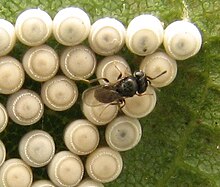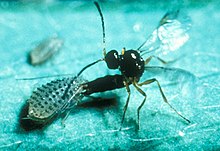Parasitoid wasp

Parasitoid wasps are a large group of
Parasitoid wasp species differ in which host life-stage they attack: eggs, larvae, pupae, or adults. They mainly follow one of two major strategies within
Parasitoidism evolved only once in the Hymenoptera, during the
Many parasitoid wasps are considered beneficial to humans because they naturally control agricultural pests. Some are applied commercially in biological pest control, starting in the 1920s with Encarsia formosa to control whitefly in greenhouses. Historically, parasitoidism in wasps influenced the thinking of Charles Darwin.[3]
Parasitoidism

Parasitoid wasps range from some of the smallest species of insects to wasps about an inch long. Most females have a long, sharp ovipositor at the tip of the abdomen, sometimes lacking venom glands, and almost never modified into a sting.[4]
Parasitoids can be classified in a variety of ways. They can live within their host's body as endoparasitoids, or feed on it from outside as ectoparasitoids: both strategies are found among the wasps. Parasitoids can also be divided according to their effect on their hosts. Idiobionts prevent further development of the host after initially immobilizing it, while koinobionts allow the host to continue its development while they are feeding upon it; and again, both types are seen in parasitoidal wasps. Most ectoparasitoid wasps are idiobiont, as the host could damage or dislodge the external parasitoid if allowed to move or moult. Most endoparasitoid wasps are koinobionts, giving them the advantage of a host that continues to grow larger and remains able to avoid predators.[4]
Hosts
Many parasitoid wasps use larval Lepidoptera as hosts, but some groups parasitize different host life stages (egg, larva or nymph, pupa, adult) of nearly all other orders of insects, especially
Some also inject a mix of secretory products that paralyse the host or protect the egg from the host's immune system; these include
Host size is important for the development of the parasitoid, as the host is its entire food supply until it emerges as an adult; small hosts often produce smaller parasitoids.[8] Some species preferentially lay female eggs in larger hosts and male eggs in smaller hosts, as the reproductive capabilities of males are limited less severely by smaller adult body size.[9]

Some parasitoid wasps mark the host with chemical signals to show that an egg has been laid there. This may both deter rivals from ovipositing, and signal to itself that no further egg is needed in that host, effectively reducing the chances that offspring will have to compete for food and increasing the offspring's survival.[10][11]
Life cycle

On or inside the host the parasitoid egg hatches into a larva or two or more larvae (polyembryony). Endoparasitoid eggs can absorb fluids from the host body and grow several times in size from when they were first laid before hatching. The first instar larvae are often highly mobile and may have strong mandibles or other structures to compete with other parasitoid larvae. The following instars are generally more grub-like. Parasitoid larvae have incomplete digestive systems with no rear opening. This prevents the hosts from being contaminated by their wastes. The larva feeds on the host's tissues until ready to pupate; by then the host is generally either dead or almost so. A meconium, or the accumulated wastes from the larva is cast out as the larva transitions to a prepupa.[12][13] Depending on its species, the parasitoid then may eat its way out of the host or remain in the more or less empty skin. In either case it then generally spins a cocoon and pupates. As adults, parasitoid wasps feed primarily on nectar from flowers. Females of some species will also drink hemolymph from hosts to gain additional nutrients for egg production.[14]
Host defenses

The hosts of parasitoids have developed several levels of defence. Many hosts try to hide from the parasitoids in inaccessible habitats. They may also get rid of their frass (body wastes) and avoid plants that they have chewed on as both can signal their presence to parasitoids hunting for hosts. The egg shells and cuticles of the potential hosts are thickened to prevent the parasitoid from penetrating them. Hosts may use behavioral evasion when they encounter an egg laying female parasitoid, like dropping off the plant they are on, twisting and thrashing so as to dislodge or kill the female and even regurgitating onto the wasp to entangle it. The wriggling can sometimes help by causing the wasp to "miss" laying the egg on the host and instead place it nearby. Wriggling of pupae can cause the wasp to lose its grip on the smooth hard pupa or get trapped in the silk strands. Some caterpillars even bite the female wasps that approach them. Some insects secrete poisonous compounds that kill or drive away the parasitoid. Ants that are in a symbiotic relationship with caterpillars, aphids or scale insects may protect them from attack by wasps.[18][19]
Parasitoid wasps are vulnerable to hyperparasitoid wasps. Some parasitoid wasps change the behavior of the infected host, causing them to build a silk web around the pupae of the wasps after they emerge from its body to protect them from hyperparasitoids.[20]
Hosts can kill endoparasitoids by sticking haemocytes to the egg or larva in a process called encapsulation.[21] In aphids, the presence of a particular species of γ-3 Pseudomonadota makes the aphid relatively immune to their parasitoid wasps by killing many of the eggs. As the parasitoid's survival depends on its ability to evade the host's immune response, some parasitoid wasps have developed the counterstrategy of laying more eggs in aphids that have the endosymbiont, so that at least one of them may hatch and parasitize the aphid.[22][23]
Certain caterpillars eat plants that are toxic to both themselves and the parasite to cure themselves.[24] Drosophila melanogaster larvae also self-medicate with ethanol to treat parasitism.[25] D. melanogaster females lay their eggs in food containing toxic amounts of alcohol if they detect parasitoid wasps nearby. The alcohol protects them from the wasps, at the cost of retarding their own growth.[26]
Evolution and taxonomy
Evolution
Based on genetic and fossil analysis, parasitoidism has evolved only once in the Hymenoptera, during the
The
| Hymenoptera |
| |||||||||||||||||||||||||||||||||||||||||||||||||||||||||||||||||||||||||||||||||||||||||||||||||||||||||||||||
Taxonomy


The parasitoid wasps are
- Scolebythidae
- Bethylidae
- Chrysididae
- Sclerogibbidae
- Dryinidae
- Embolemidae
- Tiphiidae
- Thynnidae
- Sapygidae
- Mutillidae
- Bradynobaenidae
- Chyphotidae
- Sierolomorphidae
- Braconidae
- Ichneumonidae
- Pompilidae
- Rhopalosomatidae
- Aulacidae
- Evaniidae
- Gasteruptiidae
- Stephanidae
- Megalyridae
- Trigonalidae
- Ibaliidae
- Liopteridae
- Figitidae
- Austroniidae
- Diapriidae
- Heloridae
- Monomachidae
- Pelecinidae
- Peradeniidae
- Proctotrupidae
- Roproniidae
- Vanhorniidae
- Platygastridae
- Scelionidae
- Megaspilidae
- Ceraphronidae
- Mymarommatidae
- Chalcidoidea(19 families)
- Ampulicidae
Interactions with humans
Biological pest control


Parasitoid wasps are considered beneficial as they naturally control the population of many
One of the first parasitoid wasps to enter commercial use was
Commercially, there are two types of rearing systems: short-term seasonal daily output with high production of parasitoids per day, and long-term year-round low daily output with a range in production of 4–1000 million female parasitoids per week, to meet demand for suitable parasitoids for different crops.[40]
In culture
Parasitoid wasps influenced the thinking of Charles Darwin.[b] In an 1860 letter to the American naturalist Asa Gray, Darwin wrote: "I cannot persuade myself that a beneficent and omnipotent God would have designedly created parasitic wasps with the express intention of their feeding within the living bodies of Caterpillars."[3] The palaeontologist Donald Prothero notes that religiously-minded people of the Victorian era, including Darwin, were horrified by this instance of evident cruelty in nature, particularly noticeable in the Ichneumonidae.[42]
Notes
- ^ Trioxys complanatus has been introduced to Australia to control the spotted alfalfa aphid.[36]
- ^ Darwin mentions "parasitic" wasps in On the Origin of Species, Chapter 7, page 218.[41]
References
- PMID 23938758.
- S2CID 219039881.
- ^ a b "Letter 2814 — Darwin, C. R. to Gray, Asa, 22 May [1860]". Retrieved 2011-04-05.
- ^ ISBN 978-1-118-84615-5.
- ^ Cushman R. A. (1916). "Syntomaspis druparum, the apple-seed chalcid". Journal of Agricultural Research. 7: 487–502.
- ISBN 978-0-306-45881-1.
- PMID 25670535.
- PMID 15647346.

- S2CID 28101144.
- .
- PMID 20569133.

- ^ "Cotesia congregata - a parasitoid wasp". entnemdept.ufl.edu. Retrieved 2017-10-02.
- S2CID 84430254.
- PMID 1946402.
- ISBN 9781461374374.
- PMID 21994724.

- PMID 7810989.
- .
- S2CID 23457678.
- PMID 32846685.
- PMID 12563031.
- PMID 22364271.
- PMID 19274098.
- PMID 22342747.
- PMID 23430653.
- PMID 28376325.

- ^ Schulmeister, S. "Symphyta". Retrieved 28 November 2016.
- ^ PMID 28343967.
- ^ PMID 21540117.
- PMID 16332211.
- ^ PMID 14711084.
- PMID 28343967.
- )
- S2CID 84996305.
- ^ "Parasitoid Wasps (Hymenoptera)". University of Maryland. Retrieved 6 June 2016.
- PMID 15012401.
- ^ "Enforce for Greenhouse Whitefly Control". New Zealand: Bioforce Limited. Retrieved 26 January 2024.
- PMID 15012334.
- ^ On the Origin of Species, Chapter 7, page 218.
- ISBN 978-0-231-54316-3.




